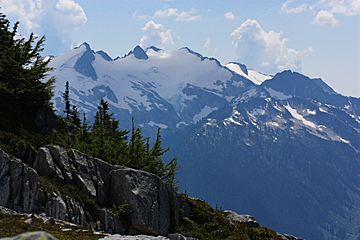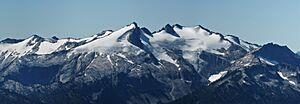Snowking Mountain facts for kids
Quick facts for kids Snowking Mountain |
|
|---|---|

Snowking Mountain showing north aspect
|
|
| Highest point | |
| Elevation | 7,433 ft (2,266 m) |
| Prominence | 1,593 ft (486 m) |
| Geography | |
| Parent range | North Cascades |
| Topo map | USGS Snowking Mountain |
| Climbing | |
| Easiest route | Alpine Scrambling |
Snowking Mountain is a big mountain peak in Skagit County, Washington state. It stands about 7,433 feet (2,266 meters) tall. This mountain is located inside the beautiful Glacier Peak Wilderness.
Snowking Mountain is found west of the main ridge of the North Cascades mountain range. It's about 18 miles northeast of a town called Darrington. Snowking Mountain has two smaller peaks nearby: West Peak (7,425 feet) and Middle Peak (7,400 feet). The closest taller mountain is Mount Misch, which is about 5.75 miles (9.25 km) to the southeast.
A large, unnamed glacier sits on the north side of Snowking Mountain. People often call it Snowking Glacier. Below this glacier are three lakes: Snowking Lake, Found Lake, and Cyclone Lake. All the water that runs off Snowking Mountain eventually flows into the Skagit River.
Weather Around Snowking Mountain
Snowking Mountain is in a special climate zone called the marine west coast climate. This type of weather is common in western North America. Most of the weather systems that bring rain or snow start over the Pacific Ocean. They then travel northeast towards the Cascade Mountains.
When these weather systems reach the North Cascades, the tall mountains force the air upward. This process is called Orographic lift. As the air rises, it cools down and drops its moisture. This means the west side of the North Cascades gets a lot of rain or snow.
During winter, it's usually cloudy and snowy. But in summer, high-pressure systems over the Pacific Ocean often bring clear skies. Because the ocean affects the weather, the snow here tends to be wet and heavy. This can make the risk of avalanches higher.
How Snowking Mountain Was Formed
The North Cascades mountains have some of the roughest land in the Cascade Range. You can see jagged peaks, sharp ridges, deep valleys carved by glaciers, and tall granite spires. Amazing things happened millions of years ago to create these different landscapes. These events also caused big changes in height across the Cascade Range, leading to different climates.
The Cascade Mountains started forming millions of years ago, during a time called the late Eocene Epoch. This happened because the North American Plate was slowly moving over the Pacific Plate. This movement caused many volcanic eruptions. Also, small pieces of the Earth's crust, called terranes, came together to form the North Cascades about 50 million years ago.
Later, during the Pleistocene period, which was over two million years ago, huge sheets of ice called glaciers moved across the land. These glaciers advanced and then melted back many times. As they moved, they scraped away the land and left behind piles of rock. The river valleys in this area have a "U" shape because of these recent glaciers.
The main things that created the tall peaks and deep valleys of the North Cascades are uplift (when land pushes up) and faulting (when parts of the Earth's crust slide past each other), along with the work of glaciers.

More Information
- Weather forecast: Snowking Mountain
- Snowking aerial photo: PBase
- Climbing Snowking: YouTube



